Health Service Utilization of People Experiencing Homelessness and Engaging with Community Paramedics: A Pre-Post Study
|
Authors: John Taplin, ACP MSc; Ian Blanchard, ACP PhD; Cheryl Barnabe, MD MSc; Christopher Doig MD MSc; Lindsay Crowshoe MD; Fiona Clement, PhD Introduction: The City Centre Team (CCT) is a mobile integrated health care program consisting of advanced care paramedics who deliver community paramedic care as part of an interdisciplinary team in Calgary. The CCT is designed to address the unmet health needs of people experiencing homelessness who are underserved in primary care. Objective: To compare the rates, characteristics, and costs of health service utilization of patients interacting with the CCT before and after their index visit. Methods: The characteristics of health services, including EMS events, physician claims, and pharmaceutical dispensations were compared in the year prior to and in the year following the initial CCT visit from April 2016 to December 2018. Administrative databases were linked, and utilization rates and costs were analyzed between periods using incident rate and cost ratios in this pre-post retrospective cohort study. Results: There was a total of 4760 CCT visits for 1360 unique patients during the study period that were included in the analysis. Following the initial CCT visit there were either no significant changes or an increase in the utilization and costs of acute health services. Likewise, there was also an observed increase in rates of primary care physician claims and costs. Pharmaceutical dispensations from community pharmacies increased, while their associated costs were not significantly different. Patients who had no pharmaceutical dispensations and those without physician claims in the pre-period were significantly less likely to have no dispensations and claims in the post-period. EMS events and associated costs were observed to increase between periods with presenting conditions primarily related to substance use and mental health disorders in both periods.
Conclusions: In the year following the initial CCT visit there were small but significant increases in the connectedness to care for people experiencing homelessness. This data suggests that the continued development and implementation of paramedics as part of an interdisciplinary care team are able to increase access to care for a traditionally underserved population with complex health needs. Research that identifies specific conditions which may benefit from community paramedic care and methods to reduce barriers is necessary to further improve access. |
About the author:
 |
|
Presenter Biography Canadian Paramedicine Research Day May 26, 2022 John Taplin, ACP MSc (he/him) John has over 16 years of experience as a paramedic and has a Master of Science in Community Health Sciences from the University of Calgary, specializing in health economics. He holds an undergraduate degree in economics from the University of Calgary and has worked in diverse roles including in paramedic leadership, as a policy analyst for the Government of Alberta, and as a research analyst with the Health Technology Assessment Unit at the University of Calgary. He works as a community paramedic on the Alberta Health Services (AHS) Mobile Integrated Health City Centre Team in Calgary - program directed at providing health services to people experiencing homelessness and with addictions and mental health disorders. He also works as an ACP on ambulance for AHS EMS in Calgary, and as a community paramedic and advisor for Siksika Health Services Aisokinaipiyokiiks, a community paramedic program on Siksika Nation. |


Commentary